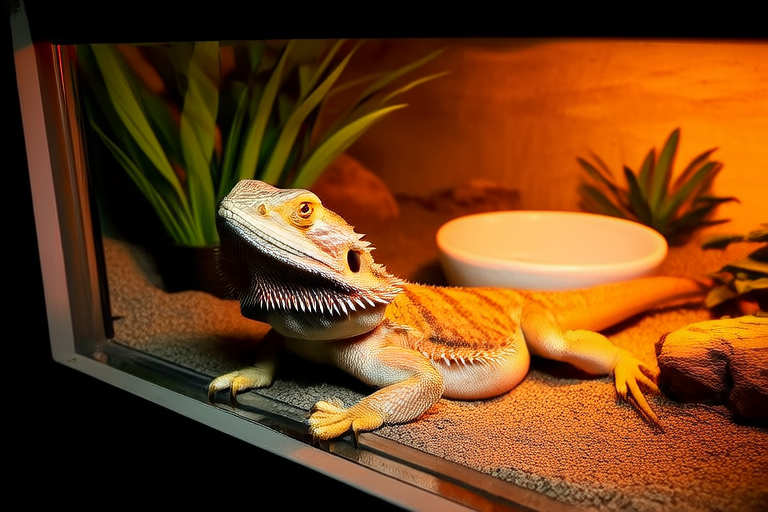How to Create the Perfect Habitat for Your Bearded Dragon
Welcome to the world of bearded dragon ownership! These fascinating creatures require specific environmental conditions to thrive. This guide will walk you through setting up the perfect habitat, ensuring your bearded dragon enjoys optimal health and happiness.
Ideal Tank Size Based on Dragon Age
The size of the enclosure is crucial for your bearded dragon’s well-being. Juvenile dragons (under six months) need a minimum of 29 gallons, while adults require at least 40 gallons. For multiple adult dragons, consider a larger tank or separate enclosures to prevent stress and potential aggression.
Appropriate Lighting Including UVB Requirements and Duration
Your bearded dragon needs full-spectrum UVB lighting to synthesize vitamin D3, which aids calcium absorption. Install a high-quality UVB lamp designed for reptiles, and place it within 12 inches of the basking area. Ensure the light covers at least half of the tank’s floor. Replace the bulb every six months, even if it still works, to maintain UVB output. Provide 10-12 hours of light daily, mimicking natural daylight cycles.
Temperature Gradients (Basking Spot and Cool Side)
Maintain a temperature gradient within the tank, ranging from 85-90°F on the warm side to 75-85°F on the cool side. Use a thermometer to monitor temperatures accurately. A heat lamp or ceramic heater provides the basking spot, reaching around 100-110°F. The cool side allows your dragon to regulate its body temperature by moving between warmer and cooler areas.
Substrate Options with Safety Considerations
Selecting the right substrate is vital for preventing impaction. Avoid sand, wood shavings, and gravel due to their risk of ingestion. Instead, opt for paper towels, reptile carpet, or calcium sand specifically designed for bearded dragons. Regularly clean the substrate to minimize bacteria growth and ensure your dragon’s safety.
Hiding Spots and Decorations for Mental Stimulation
Incorporate hiding spots and climbing structures to enrich your dragon’s environment. Use caves, tunnels, and branches to encourage exploration. Ensure all items are securely placed to prevent accidents. Providing variety stimulates mental activity and reduces stress.
Proper Ventilation
Ensure adequate air circulation by choosing a tank with mesh tops or adding ventilation holes. Proper airflow prevents humidity buildup, reducing the risk of respiratory infections. However, avoid drafts that could cause temperature fluctuations.
Feeding Areas Setup
Designate a specific area for feeding to prevent contamination. Place food bowls on the cool side of the tank, away from the basking spot. Clean the bowl regularly to maintain hygiene. Some owners prefer feeding outside the tank to keep the enclosure cleaner.
Regular Cleaning Schedule
A consistent cleaning routine keeps your dragon healthy. Spot-clean daily by removing waste. Deep clean weekly, disinfecting all surfaces and replacing substrate. Thoroughly dry the tank before returning your dragon to ensure no residual moisture remains.
Common Mistakes to Avoid When Setting Up the Habitat
- Incorrect lighting: Failing to provide sufficient UVB can lead to metabolic bone disease. Ensure the correct type and placement of lights.
- Inadequate temperature regulation: Insufficient heating can cause lethargy and poor digestion. Overheating can lead to dehydration and organ failure.
- Unsafe substrate: Choosing substrates that can be ingested poses a risk of impaction. Opt for safer alternatives.
- Lack of hiding spots: Not providing enough shelter can stress your dragon, affecting its overall health.
- Poor ventilation: Insufficient airflow can lead to respiratory issues. Ensure proper air circulation without drafts.
- Improper feeding areas: Feeding in the same area as defecation increases the risk of bacterial infection. Designate a clean space for meals.
- Irregular cleaning: Neglecting to clean the tank regularly can result in harmful bacteria buildup, affecting your dragon’s health.
By following these guidelines, you’ll create an ideal habitat for your bearded dragon, promoting its health and happiness. Remember, the key to successful reptile ownership lies in understanding and meeting your pet’s unique needs.
